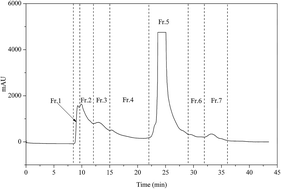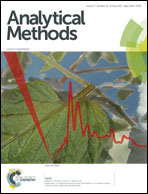An accurate and highly efficient method for finding antioxidant chemicals from Capsicum annuum L.†
Abstract
Two-dimensional preparative high-performance liquid chromatography (HPLC) was used on the non-aqueous mobile phase in the separation of weakly polar compounds from Capsicum annuum L. The resulting silica column, coupled with an amide column, showed good orthogonality with the non-aqueous mobile phase, and two separate compounds were efficiently isolated in purity above 97%. The relative antioxidant activities of the purified compounds were assessed by a unique cellular antioxidant activity (CAA) model using an anti-oxidative response element (ARE) to regulate the expression level of the luciferase reporter gene, with tert-butyl hydroquinone (TBHQ) as positive control. A luciferase cellular antioxidant activity unit (LCAA) for the measurement of antioxidant capacity has been defined by the antioxidant capacity of 1.5 μg mL−1 TBHQ, and the relative antioxidant capacities of two active compounds of interest, Fraction 5-4 and Fraction 5-5, were found to be 0.397 LCAA and 0.523 LCAA, respectively. The protocols described will be of considerable assistance in the development of functional foodstuffs.


 Please wait while we load your content...
Please wait while we load your content...